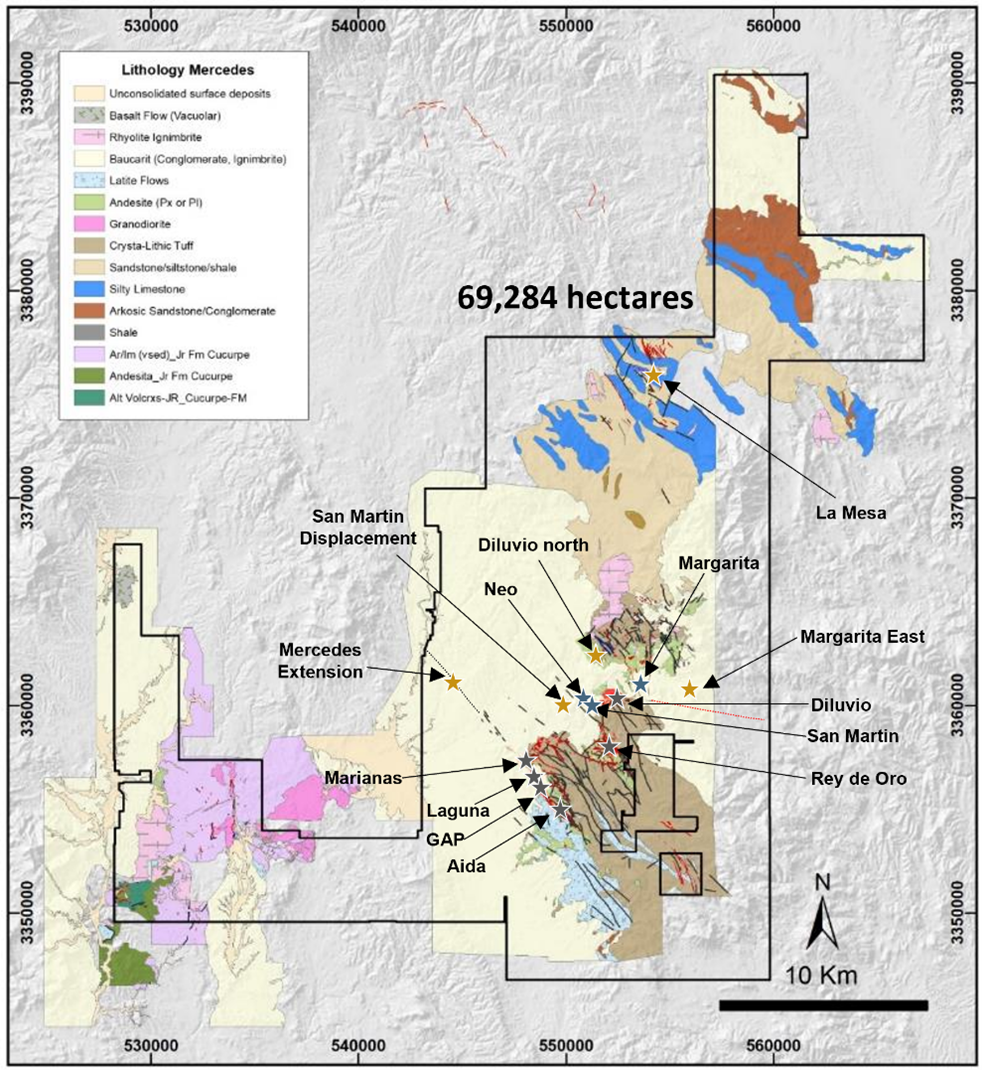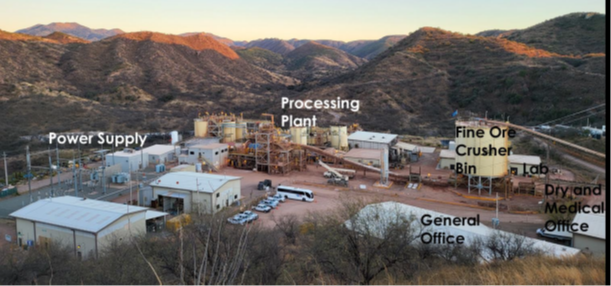Overview
PROJECT DESCRIPTION
The 100% owned Mercedes Gold Mine is located in Sonora, Mexico, approximately 250 km northeast of Hermosillo, Mexico and 300 km south of Tucson, Arizona. Mercedes is accessible by paved highway from Hermosillo, which is served by an international airport.
The Mercedes property consists of 43 mineral concessions totaling 69,284 hectares. The concession titles are valid for 50 years from the date titled and can be renewed for another 50 years. The areas of interest at Mercedes are located on private land. Bear Creek has leases with four local ranches totaling 13,306 hectares. The total monthly payment of these leases is US$10,500. Renewal dates are between November 2022 and October 2023 for 3-4 year terms.
OWNERSHIP AND PRODUCTION HISTORY
Exploration and small scale mining activities have occurred in the Mercedes mine vicinity since the early 1900’s. Commencing in 1993, the Mercedes vein systems underwent more modern and systemic exploration and in 2007 the property was acquired by Yamana Gold. Yamana conducted extensive exploration and feasibility study work between 2007 and 2011 which culminated in the construction of the Mercedes Mine. Commercial production commenced in 2011 and continued under Yamana until 2016 when the Mercedes Mine was purchased by Premier Gold Mines. In 2011, Premier Gold Mines was acquired by Equinox Gold. The Mercedes mine was a non-core asset during the latter years of its ownership by Premier and under its ownership by Equinox, which sold the Mercedes Mine to Bear Creek Mining in April 2022.
Mercedes has been in continuous operation since 2011 with the exception of a brief Covid-19 related shutdown imposed by the Mexican government on all Mexican mining operations in early 2020. Annual production over this time period is shown in the following table sourced from the NI 43-101 Technical Report entitled “Mercedes Gold-Silver Mine, Sonora, Mexico” dated July 4, 2022 with an effective date of December 31, 2021 (the “2022 Mercedes Report”):
Historical Production, Mercedes Mine
| Year | Ore Processed (000 tonnes) |
Gold Grade (gpt Au) |
Silver Grade (gpt Ag) |
Gold Ounces (000) |
Silver Ounces (000) |
|---|---|---|---|---|---|
| 2011 | 48 | 7.60 | 114.5 | 8 | 39 |
| 2012 | 603 | 6.43 | 78.4 | 116 | 490 |
| 2013 | 671 | 6.16 | 79.4 | 129 | 615 |
| 2014 | 682 | 5.09 | 55.9 | 105 | 398 |
| 2015 | 713 | 3.96 | 43.3 | 84 | 383 |
| 2016 | 513 | 4.52 | 48.4 | 93 | 425 |
| 2017 | 684 | 3.93 | 37.6 | 83 | 338 |
| 2018 | 699 | 3.39 | 37.6 | 69 | 309 |
| 2019 | 668 | 2.91 | 26.2 | 60 | 191 |
| 2020 | 399 | 2.87 | 33.1 | 35 | 168 |
| 2021 | 512 | 2.69 | 21.2 | 42 | 123 |
| Total | 6,191 | 4.24 | 47.4 | 824 | 3,479 |
GEOLOGY AND MINERALIZATION
The Mercedes Mine is located in the northwestern edge of the epithermal gold and silver deposits belt of Mexico.
The Mercedes Mine area is underlain by a thick succession of shallow-marine shelf carbonate and siliciclastic rocks ranging in age from Jurassic to Cretaceous, which have been moderately to strongly faulted and folded.
Andesitic flows and flow breccias have been deposited and preserved in at least three west-northwest thickening basins, on the margins of the northwest trending arches. This andesite package, locally over 500 m thick, and the contact zone with the underlying tuff, host all known economic epithermal vein deposits in the district.
A total of 16.5 km of gold-silver bearing epithermal low sulphidation veins have been identified within or along the margins of the andesite-filled basins, which constitute the primary exploration target on the property. Major veins, like those of the Mercedes vein system, typically trend N30º -70ºW at 60º to 90º dips northwest, following the major regional structural pattern. Other veins trend variably from east-west to north-south, or even northeast. Veins typically dip at greater than 60º, but locally range as low
as 25º.
Mineral Reserves and Resources
The Mercedes property is estimated to contain the following Mineral Resources and Mineral Reserves as of December 31, 2021. Please refer to the footnotes below and to the 2022 Mercedes Report for additional information.
MINERAL RESOURCES (inclusive of Mineral Reserves)
| Mineral Resource Class | Tonnes | Grade | Contained Metal | ||
|---|---|---|---|---|---|
| (thousands) | Au (gpt) | Ag (gpt) | Au oz (thousands) |
Ag oz (thousands) |
|
| Measured | 865 | 4.55 | 33.73 | 127 | 938 |
| Indicated | 2,914 | 4.79 | 44.93 | 449 | 4,209 |
| Measured + Indicated | 3,779 | 4.73 | 42.37 | 575 | 5,147 |
| Inferred | 884 | 4.50 | 41.02 | 128 | 1,167 |
- The independent qualified person for the Mineral Resource Estimate (“MRE”), as defined by National Instrument (“NI”) 43-101 guidelines, is Pierre-Luc Richard, P.Geo. The effective date is December 31, 2021.
- These Mineral Resources are not Mineral Reserves as they do not have demonstrated economic viability. The quantity and grade of reported Inferred Mineral Resources in this MRE are uncertain in nature and there has been insufficient exploration to define these Inferred Mineral Resources as Indicated or Measured; however, it is reasonably expected that the majority of Inferred Mineral Resources could be upgraded to Indicated Mineral Resources with continued exploration.
- Mineral resources are presented as undiluted and in situ for an underground scenario and are considered to have reasonable prospects for economic extraction. Mineral resources show sufficient continuity and isolated blocks were discarded; therefore, the herein MRE meets the CIM Guidelines published in November 2019.
- The MRE was prepared using VulcanTM v.2020.1 and is based on 2,894 drill holes and 21,554 channels.
- The MRE encompasses 13 deposits each defined by individual wireframes.
- High-grade capping was done on the raw assay data and established on a per zone basis for gold and silver.
- Density values were calculated based on 999 density measurements.
- Grade model Mineral Resource estimation was calculated from drill hole data using an Ordinary Kriging and ID3 interpolation methods.
- The estimate is reported using a cut-off grade varying from 2.0 to 2.1 gpt Au. The cut-off grade was calculated using a gold price of USD1,350/oz. The cut-off grade will be re-evaluated in light of future prevailing market conditions and costs.
- The MRE presented herein is categorized as Inferred, Indicated, and Measured Mineral Resources. The Inferred Mineral Resource category is constrained to areas where the drill spacing is around or less than 15 m, the Indicated Mineral Resource category is constrained to areas where drill spacing is around or less than 25 m, and the Inferred Mineral Resource category is constrained to areas where drill spacing is around or less than 45 m. In all cases, reasonable geological and grade continuity were also a criteria during the classification process.
- Calculations used metric units (metre, tonne). Metric tonnages were rounded and any discrepancies in total amounts are due to rounding errors.
- CIM definitions and guidelines for Mineral Resource Estimates have been followed.
- The QP is not aware of any known environmental, permitting, legal, title-related, taxation, sociopolitical or marketing issues, or any other relevant issues that could materially affect this MRE.
MINERAL RESERVES
| Mineral Reserve Class | Tonnes | Grade | Contained Metal | ||
|---|---|---|---|---|---|
| (thousands) | Au (gpt) | Ag (gpt) | Au oz (thousands) |
Ag oz (thousands) |
|
| Proven Underground | 344 | 5.65 | 40.7 | 62.5 | 449 |
| Probable Underground | 1,873 | 3.40 | 26.9 | 204.5 | 1,620 |
| Proven & Probable | 2,217 | 3.75 | 29.0 | 267.0 | 2,069 |
- CIM Definitions Standards on Mineral Resource and Reserves (2014) have been followed.
- The effective date of the 2021 Reserve Statement is December 31, 2021.
- Mineral Reserves are minable tonnes and grades; the reference point is the mill feed at the primary crusher.
- Mineral Reserves are estimated at a cut-off of 2.1 gpt Au, except Diluvio, which is estimated at 2.0 gpt Au.
- Cut-off grade assumes a price of gold of US$1,350 per ounce, a 95.5% gold metallurgical recovery; US$38.41/t (Diluvio) and US$43.26 (other deposits) mining cost, US$19.75/t processing costs, US$15.61/t G&A, and US$8.48/oz refining costs.
- A minimum mining width of 3.5 m was used in the creation of all reserve blocks.
- Bulk density for ore varies by deposit from 2.22 t/mᶾ to 2.57 t/mᶾ and 2.40 t/mᶾ for waste.
- Numbers may not add due to rounding.
- David Willock, P. Eng., is the qualified person for the mineral reserve statement as defined by NI 43-101.
Mining and Processing
The Mercedes Mine consists of six known main deposits: Mercedes; Barrancas-Lagunas; Lupita; Diluvio; Rey de Oro; and San Martin. Following the brief Covid-19 shutdown of operations in 2020, production resumed at the Diluvio and Lupita zones. The Company is currently operating primarily from the Diluvio and Lupita zones and in the process of development at the Rey de Oro and Marianas zones to resume production from the Klondike and Lagunas portals.
Each of the deposits are ramp accessed through surface portals with some underground connections between deposits.
The majority of mining will be mechanized cut & fill; however, in Diluvio and Diluvio West a longitudinal long-hole open stoping mining method is utilized where ground conditions and ore geometry allow for bulk mining methods.
Processing facilities consist of conventional milling with Merrill-Crowe recovery of precious metals and the production of doré for sale. The plant is capable of processing approximately 2,000 tpd of ore.
Current Activities
EXPLORATION AND DEVELOPMENT
Bear Creek Mining is carrying out the 2022 exploration program at Mercedes. The 2022 Mercedes exploration program consists of:
- greenfield exploration drilling in the San Martin, Diluvio Scout, Margarita and Neo zones, where highly prospective structures related to Mercedes mine gold mineralization extend beneath post mineral cover
- resource growth and reserve replacement drilling in the Marianas and Rey de Oro deposits
- Surface sampling and mapping in the Mesa zone
Immediately after acquiring Mercedes, Bear Creek focused on increasing development work and establishing the foundation for longer-term sustainable production increases. This work resulted in having 15 working faces available, more than doubling the historical average of work areas. The Company is opening working areas in the higher-grade Rey de Oro and Marianas deposits in 2022.
MERCEDES OPERATIONAL IMPROVEMENT PROGRAM
Shortly after acquiring the Mercedes Mine and completing its integration, Bear Creek carried out a GAP analysis to identify potential improvements in mine planning, operating efficiencies, and equipment utilization. Implementation of these improvements, which are attainable without unplanned investment in additional equipment or infrastructure, is underway. Targeted outcomes are to:
- increase production to a minimum of 70,000 oz Au per year
- increase ore throughput to approximately 2000 tonnes per day (the nameplate capacity of the Mercedes processing plant)
- increase the average gold grade of mined material
- increase daily development meters, and
- reduce the average all-in sustaining cost per oz of gold produced
Additional Information
Please refer to the NI 43-101 Disclosure section of this website for important information related to 2022 Mercedes Report and the information presented above.




